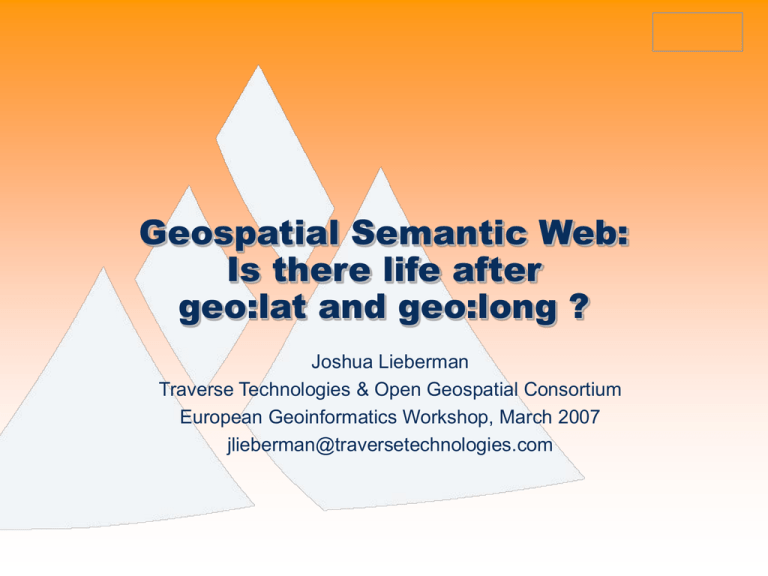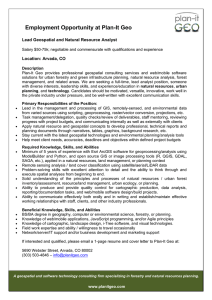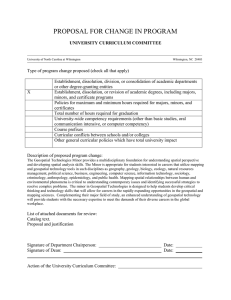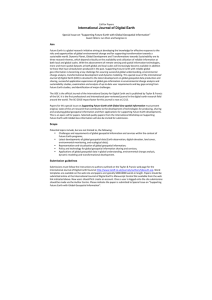Geospatial Semantic Web: Is there life after geo:lat and geo:long ?
advertisement

Geospatial Semantic Web: Is there life after geo:lat and geo:long ? Joshua Lieberman Traverse Technologies & Open Geospatial Consortium European Geoinformatics Workshop, March 2007 jlieberman@traversetechnologies.com What’s the (Geo) Problem? • • • • • • Special spatial What is geospatial interoperability? semantic Web - microformat tagging and (multiple) identity Semantic Web - (actionable) relationships and triple identity geosemantic - geotagging position Geosemantic - spatial(-temporal) theories, relationships, mediations, transformations • Feature (type) and Geometry (representation) • Model dependencies – – – – Community of discourse Scale Reference frame / coordinate system Perspective • Geospatial plus other (semantic) dimensions Joshua Lieberman - European Geoinformatics Workshop 2007 ©Traverse Technologies. Slide 2 Background • My context - earth / environmental sciences -> data manager -> Web 1.0 victim -> geospatial standards geek • What is the geospatial problem, anyway? Is it a geospatial problem? Who needs interoperability? • Playing fields and players, an arbitrary list: – Open Geospatial Consortium – Worldwide Web Consortium – SOCoP • “Standards are great, there are so many to choose from” • “OGC is full of semantics, we just don’t let much of it leak out” • “If there is artificial intelligence, does that mean there is also artificial stupidity?” Joshua Lieberman - European Geoinformatics Workshop 2007 ©Traverse Technologies. Slide 3 Geospatial Semantic Web Challenge: Interoperability • The Geospatial part – – – – • The Web part – – – • Accessibility of “secret” knowledge Interoperability between communities and domains Softer software Automated (machine to machine) reasoning and inference The Geosemantic part – – – • Distributed data - “own and maintain locally / find and access globally” Shared services, loosely or tightly coupled to geodata Interoperability between technologies, vendors, architectures The Semantic part – – – – • Maps and map visualization Features and feature geometries Geographic and other relationships Coordinate and other reference systems Feature discernment Spatial reasoning Representational dissonance No particular part – – Cognitive dissonance Context and viewpoint Joshua Lieberman - European Geoinformatics Workshop 2007 ©Traverse Technologies. Slide 4 What are OGC and OWS ? • • “The Open Geospatial Consortium, Inc. (OGC) is a non-profit, international, voluntary consensus standards organization that is leading the development of standards for geospatial and location based services” “Opengeospatial Web Services” (OWS) - OGC has been developing for some time specifications for a suite of Web services (sensu latu) and associated encodings to expose geospatial content and operations from distributed content repositories to remote clients across diverse platforms: – – – – – – GML - geographic markup language (an information model and XML schema) for encoding features (geometric representations of geography). Web Feature Service - service providing access to collections of features Web Map Service - service providing access to map layers (cartographically rendered features and images) Catalog Service / Web - service supporting (spatial) discovery of geospatial datasets and services Several other associated specifications, e.g. coordinate reference system encoding Many corresponding or related ISO standards, especially 191nn (TC211) Joshua Lieberman - European Geoinformatics Workshop 2007 ©Traverse Technologies. Slide 5 General Feature Model Joshua Lieberman - European Geoinformatics Workshop 2007 ©Traverse Technologies. Slide 6 Interoperability Stack Increasing / higher level interoperability Human-centric • Meaning - ? (OWL, RDF, MDL, …) • Vocabulary – UML, XML Schema, OWS • Encoding - ASCII, UTF-8, XML • Control – TCP, HTTP, WAP • Signal – Internet Protocol, DNS • Transport – Ethernet, WiFi, GPRS • Medium – Physical Connection Machine-centric Joshua Lieberman - European Geoinformatics Workshop 2007 ©Traverse Technologies. Slide 7 Geospatial R/Evolution • Geospatial Semantic Web: forming and distributing rich geospatial relationships across the Web • GeoRSS: adding features to information • Google Earth: the terrain as video game • GeoWeb: connecting features across the Web • GIS: adding information to features Cartography: symbolic representation of the terrain • Geography: perception of the terrain Joshua Lieberman - European Geoinformatics Workshop 2007 ©Traverse Technologies. Slide 8 Which Geospatial Role? Upper Ontologies? Geographic Infromation System Tasks / Processes Interpret Visualize Model Common Geospatial Perspective Collect Petro Aero Hydro Weather Solar Base Ontologies? Geo Information Domains Joshua Lieberman - European Geoinformatics Workshop 2007 ©Traverse Technologies. Slide 9 Use cases and roles for semantic Web processing • Cross-domain resource discovery • Heterogeneous resource query • Resource translation Trader Client Server(s) Broker Joshua Lieberman - European Geoinformatics Workshop 2007 ©Traverse Technologies. Slide 10 “Typical” Geospatial Query (Intelligence / Logistics Domain) “Which airfields within 500 miles of Kandahar support C5A aircraft?” Feature property or non-spatial information? Aero Feature or Geo Feature? Buffer or proximity? What does this mean to a GIS ? Statutory or Nautical? Straight-line or driving? Coordinate system? Afghanistan? Centroid or outline? Joshua Lieberman - European Geoinformatics Workshop 2007 ©Traverse Technologies. Slide 11 Multiple GSW Ontology Components Other Upper Ontologies OGC Upper Ontology (e.g. Feature) GeoIntel Problem Domain Ontology Aero Feature Ontologies (AIXM, DAFIF) Base Geospatial Ontology (e.g. filter encoding) Other Base Ontologies (e.g. measurements) Joshua Lieberman - European Geoinformatics Workshop 2007 ©Traverse Technologies. Slide 12 Ontologies for Enhanced GI Discovery Which airfields within 80 miles of Banda Aceh support C5A aircraft, i.e. have a runway length >= 12000 ft? Ontological (DL) description of the query concept Hybrid Ontology Approach Query concept based on Logical equivalence or subsumption Reasoning based on Application Ontology Concept John Smith Domain Ontology Ontological (DL) description of the application concept “Dafif_Airport” ID Name 1 Greenville 2 Festus Mem Airp_Ident US01357 US05536 ICAO Elev KZ 00541 KZ 00433 Type A A Joshua Lieberman - European Geoinformatics Workshop 2007 ©Traverse Technologies. Slide 13 OWL-S Service Description Components and Questions Type of Service Themes of Content Service Profile Provider / business terms Content Description Service Bindings / Messages Feature Schema Service Grounding Content Domain Bound Parameters Feature Individuals ? Process and Behavior Smart Service Consumption Service Model Service Composition Joshua Lieberman - European Geoinformatics Workshop 2007 ©Traverse Technologies. Slide 14 GSW IE and Beyond • The OGC geospatial semantic web interoperability experiment tested initial architectures and technologies for cross-domain, distributed geospatial knowledge query, leading to multiple follow-on activities. Geospatial Intelligence Query: “Which airfields within 500 miles of Kandahar support C5A aircraft” GeoRSS geospatially enabled resource references Query Domain Ontology Geospatial Ontologies workshops (resource, process, service) OWL-S Description DAFIF Ontology OWL-S Description AIXM Ontology OWL-S Description Gazetteer Ontology Aero Data (DAFIF) WFS Aero Data (AIXM) WFS Geonames Data Gazetteer Service W3C Geospatial Semantic Activities Joshua Lieberman - European Geoinformatics Workshop 2007 ©Traverse Technologies. Slide 15 A Theory of One’s Own • Classical Scientific Method: – Observation -> Hypothesis -> Test • SWE: – Procedure -> Sensor -> Measurement -> Observation -> Hypothesis • John Wesley Powell: – Multiple Hypothesis -> Observation -> Selection • Practical / Tenure track – Theory -> Procedure -> Measurement -> Observation -> Publication • In “reality” observations are always predicated upon a theory, although they may subsequently induce theory revision. Joshua Lieberman - European Geoinformatics Workshop 2007 ©Traverse Technologies. Slide 16 Problems of heterogeneity • Semantics: two names for the same thing • Semiotics: one name for two different things • Schizophrenia (cognitive dissonance): two names for two different things Vertical Obstruction Lighthouse Joshua Lieberman - European Geoinformatics Workshop 2007 ©Traverse Technologies. Slide 17 Semantic quandaries • Two co-located shapes -> “semantic heterogeneity” • Agree “obstruction” equals “lighthouse” -> boat crashes into a water tower • Agree lighthouse “is a” vertical obstruction -> ship ignores light buoy, hits shoal • Agree vertical obstruction “is a” lighthouse -> plane hits watertower • We have “cognitive heterogeneity” -> two theories for the same reality Joshua Lieberman - European Geoinformatics Workshop 2007 ©Traverse Technologies. Slide 18 Unsettling Solutions • Possible solution: intersect theories -> lighthouse and vertical obstruction are both “elevations”, but little may be agreed on the role or behavior of that shared reality. Semantic technology provides few tools to distinguish the “theories” of the subclasses. Elevation Aero Hazard Marine Navigation Aid Vertical Obstruction Lighthouse Joshua Lieberman - European Geoinformatics Workshop 2007 ©Traverse Technologies. Slide 19 Top of the Interoperability Stack Increasing / higher level interoperability Human-centric • Purpose – Enlightenment, tenure • Perception – Visual - aural - tactile • Theory - persistence, consequence • Discernment – Feature, context • Application – Discovery, analysis, profit • Representation– geometry, equation • Ontology – domain, upper, lower Machine-centric Joshua Lieberman - European Geoinformatics Workshop 2007 ©Traverse Technologies. Slide 20 W3C Geo XG • W3C Geospatial Incubator is a new type of activity for short-term and/or startup goals • The (proposed) Geo XG has three objectives which address needs of the Local Web: – Immediate: update and harmonization with GeoRSS of the W3C Basic Geo vocabulary, aka simpler than possible geospatial ontology. – Short Term: draft recommendations for a geospatial ontology focused on Web resources and tasks. – Longer Term: draft a charter for a proposed W3C Local Web WG and/or IG to address issues beginning with geotags and continuing towards geospatial enablement of the Semantic Web. • Largely open to public participation • Chartered until June 2007 • http://www.w3.org/2005//Incubator/geo/ Joshua Lieberman - European Geoinformatics Workshop 2007 ©Traverse Technologies. Slide 21 W3C 2003 Geo Vocabulary • Devised and posted by Dan Brickley (danbri) • Not a Note or Recommendation • Separate latitude & longitude properties, presumes WGS 84 • Implies a point “feature” and single position. • Makes no other assertion as to the meaning of the coordinates or their relationship to the item or resource they characterize. • Geo:lat and geo:long are also used for geotagging other content (e.g. XHTML microformats). The vocabulary defines a class 'Point', whose members are points. Points can be described using the 'lat' and 'long' properties. <geo:Point> <geo:lat>55.701</geo:lat> <geo:long>12.552</geo:long> </geo:Point> In common usage, the containing Point is dropped, for brevity. <?xml version="1.0"?> <rss version="2.0" xmlns:geo="http://www.w3.org/2003/01/geo/wgs84_pos#" > <channel> ... <item> <title>An example annotation</title> <link>http://example.com/geo</link> <description>Just an example</description> <geo:lat>26.58</geo:lat> <geo:long>-97.83</geo:long> </item> Joshua Lieberman - European Geoinformatics Workshop 2007 ©Traverse Technologies. Slide 22 GeoRSS 1.0 Content “Featurizing” Model Joshua Lieberman - European Geoinformatics Workshop 2007 ©Traverse Technologies. Slide 23 GeoRSS Examples • Simple • GML • • • • • • • <georss:where> <gml:Point> <gml:pos>45.256 -71.92</gml:pos> </gml:Point> </georss:where> • • • • • • <georss:where> <gml:Polygon> <gml:exterior> <gml:LinearRing> <gml:posList> 45.256 -110.45 46.46 -109.48 43.84 109.86 45.256 -110.45 </gml:posList> </gml:LinearRing> </gml:exterior> </gml:Polygon> </georss:where> • • • • <georss:point>45.256 -71.92</georss:point> <georss:line>45.256 -110.45 46.46 -109.48 43.84 -109.86</georss:line> <georss:polygon> 45.256 -110.45 46.46 -109.48 43.84 109.86 45.256 -110.45 </georss:polygon> <georss:box>42.943 -71.032 43.039 69.856</georss:box> <georss:featuretyeptag>city</georss:featuretyp etag> <georss:relationshiptag>is-containedwithin</georss:relationshiptag> • • • • • GeoRSS Simple maps directly onto GeoRSS GML ! Joshua Lieberman - European Geoinformatics Workshop 2007 ©Traverse Technologies. Slide 24 SOCoP: Spatial Ontology Community of Practice • SOCoP is chartered as a Community of Practice under the Best Practices Committee of the Federal CIO Council. • Charter: The strict purpose and focus of the Spatial Ontology Community of Practice (SOCoP) is to foster collaboration among researchers, technologists & users of spatial knowledge representations and reasoning towards the development of a set of core, common spatial ontologies for use by all in the Semantic Web. As a Community of Practice SOCoP using open collaboration and open standards, SOCoP developed ontologies will offer increased interoperability of spatial data across government (via synchronization with Geospatial Profile of FEA & GeoLOB) as well as across the entire spectrum of the World Wide Web (via W3C, ISO, OGC, etc.). SOCoP represents a strategic investment for ontology development, building on core ontological competencies, documenting best practices, and creating opportunities to partner with other cross domain and ontology COP groups. Among other things SOCoP can help inventory geospatial ontologies, develop an approach to institutionalizing and streamline the effort to support the development and management of ontologies across the GeoLOB. Joshua Lieberman - European Geoinformatics Workshop 2007 ©Traverse Technologies. Slide 25 Geospatial Semantic Web Standards (?) • Geospatial Ontologies – – – – – – Neogeo / GeoRSS Feature metamodel Feature types Geonames / toponymology Spatial relationships Coordinate reference systems • Geospatial Discovery – Indexing vs modeling – GeoRSS: geographic assertions over resources – GRL: Geo resource locator – GREF: Geo reference – GNS: Geo Name Server • Geosemantic Reasoning – – – – – Geospatial subsumption Processing spatial relationships Geospatial rules (Geo) SPARQL ? Visual reasoning - map and reality • Geospatial Semantic Web Services – (Does) content matter? – Transformation services – Mediation (semiotic, semantic, cognitive) and client perspective Joshua Lieberman - European Geoinformatics Workshop 2007 ©Traverse Technologies. Slide 26 Geospatial Semantic Convergence • When geography-on-demand joins knowledge-with-location, the result will be a richer and more capable Web of physical resources, a Geospatial Semantic Web or Local Web having identity, connection, and locality GIS Guilds Geographic representation standards Geospatial Web Geospatial Web services architecture standards Geospatial Enablement Local Geospatial enablement of enterprise information Semantic enablement of the World Wide Web Information Silos Resource relationship standards Resource identifier and transport standards Web of Knowledge Web Semantic Web Joshua Lieberman - European Geoinformatics Workshop 2007 ©Traverse Technologies. Slide 27 What do you see is next?




